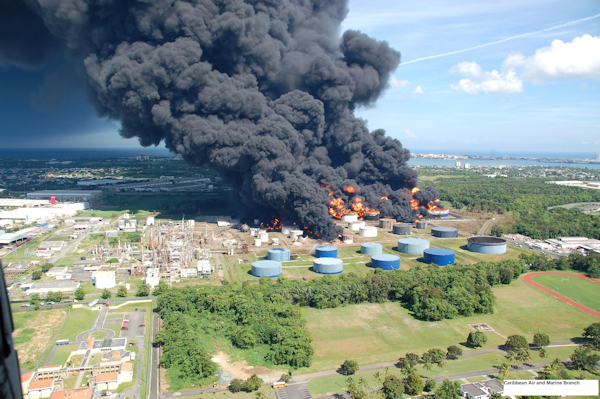SEJournal Online is the digital news magazine of the Society of Environmental Journalists. Learn more about SEJournal Online, including submission, subscription and advertising information.
 |
 |
| Above, a fire and explosion in 2009 sent flames and smoke plumes into the air at the Caribbean Petroleum Corporation near San Juan, Puerto Rico. Photo: U.S. Chemical Safety Board. |
Issue Backgrounder: Chemical Safety Board May Have Finally Cleaned Its Slate. What Now?
By Joseph A. Davis
Blaming the messenger is as American as apple pie. And the U.S. Chemical Safety and Hazard Investigation Board is a messenger that gets its share of blame.
Partly it’s the job the Chemical Safety Board is tasked with, which is to study the evidence of and find the causes for often-deadly leaks, fires, explosions and spills — and let people know about how to make things safer.
For the past decade or more,
the CSB has been a disaster itself,
mired in dysfunction, disarray and scandal.
But for the past decade or more, the CSB has been a disaster itself, mired in dysfunction, disarray and scandal, all the while surrounded and sniped at by powerful political enemies.
Now, some think, it has cleared the rubble, cleaned house and prepared to do its job effectively again. But will it? The coming months will begin to answer that question.
The chemical industry’s grand bargain
Our story begins with the 1984 spill of toxic methyl isocyanate in Bhopal, India, that immediately killed at least 3,000 people living around the plant, and thousands more later. It was one of the worst industrial accidents ever.
At the time, the chemical industry in the U.S. was largely unregulated as far as safety was concerned. The chemical industry has never wanted the government to tell them how to run their plants. But Bhopal was such a big deal that many in Congress felt the feds should do something.
The upshot was a series of laws, starting with the Emergency Planning and Community Right-to-Know Act of 1986. Behind EPCRA and related laws was a grand bargain: the U.S. would not regulate chemical safety if the industry would agree to disclose the risks it presented to neighboring communities. The theory was that knowledge would lead to community pressure making plants safer.
Sure, there were chemical laws before that, but they didn’t do enough. The Toxic Substances Control Act of 1976 had tried but had so many legal defects that it was nearly impossible to enforce (this was later remedied).
The Occupational Safety and Health Act of 1970 was another; its Process Safety Management rule was not issued until 1992, and was mainly meant to protect workers, not communities.
The CSB has no regulatory powers. Instead, it is empowered to investigate the root cause of incidents, and to make findings and recommendations about how to prevent them in the future. In this, it resembles the National Transportation Safety Board.
An (unevenly) working CSB
The CSB was legislatively authorized by the Clean Air Act Amendments of 1990, although it was not funded by Congress or appointed until 1998.
The CSB did have some good years once it got started. After major accidents, it promptly dispatched investigators with chemical engineering expertise, and issued findings and reports within reasonable time frames.
At other times, though, not all was well at the CSB. Problems arose during the tenure of Chairman Rafael Moure-Eraso, an Obama administration appointee confirmed by the Senate in 2010.
Moure-Eraso resigned in 2015 after allegations of misconduct and congressional probes into poor staff morale and ineffective leadership. He was replaced by Vanessa Allen Sutherland, who was still chair when Trump took office in January 2017.
Former President Donald Trump tried three times to defund and destroy (may require subscription) the CSB. Congress never went along. Trump first proposed zeroing out its budget the year he took office. Morale deteriorated even further and staff began leaving.
Ultimately, Sutherland resigned as chair in May 2018, without finishing the final two years of her term. She gave no reason, but the resignation was viewed by some as a response to Trump’s efforts to undermine the agency.
Limping forward
At this point it became a very real question whether the CSB could keep a quorum (may require subscription) — or even the staff it needed to function. The law sets a quorum for the five-member board at three. But the rules also outline some complicated ways for the CSB to keep operating, even without a quorum.
Following Sutherland’s departure, sitting board member Kristen Kulinowski (may require subscription) took (what was left of) the helm in the capacity of “interim executive.” Kulinowski was an Obama appointee and the last remaining CSB board member (the actual chairperson, under the rules, has to be presidentially appointed and Senate-confirmed).
The CSB limped forward. Trump ultimately nominated, and the Senate confirmed, Katherine Lemos, as chair in March 2020.
The CSB kept limping forward. Lemos was accused of unauthorized spending to the tune of roughly $100,000 — a charge which was upheld by the inspector general of the U.S. Environmental Protection Agency. Lemos resigned in June 2022. By that time Joe Biden had replaced Trump as president.
Biden appointed Steve Owens as a CSB board member in 2021 and as board chair in 2022. He still holds that post. Ultimately Biden appointed two more members in 2022 and 2023, giving the CSB a functioning quorum, if not a full five members.
Clearing the rubble and building anew
The Trump-era CSB had undertaken and completed relatively few investigations of safety incidents, and had been criticized for accumulating a backlog of unresolved cases. Under Owens, the new CSB worked hard (may require subscription) to staff up and clear the backlog.
The problem was that chemical accidents not only continued, but actually had been happening at an accelerated pace during the CSB’s troubled years. Its challenge was to reboot (may require subscription).
Today, the CSB stands
at what could be the
dawn of a new era.
Today, the CSB stands at what could be the dawn of a new era. Journalist Jeff Johnson, who has covered the CSB for Chemical & Engineering News doggedly over much of its history, recently interviewed (may require subscription) Owens.
The chairman has pointed with pride to how much the CSB has done to restore its functionality. Seventeen uncompleted investigations have now been completed, leaving a backlog of only two, started recently.
As hiring has gone forward, the once-depleted staff levels have been largely replenished to pre-Trump levels. The Biden administration is supporting a fiscal 2024 budget request of $17.4 million, a 20% increase over 2023.
But questions remain about the agency’s future. While it was catching up with its backlog, the CSB took on very few new investigations, and Owens says he wants to open new ones at a measured pace to avoid a new backlog.
Meanwhile, a catastrophe like the 2013 West, Texas, ammonium nitrate explosion, which killed 15, could still happen. That’s because the federal government has done little to strengthen safety regulations.
And a deadlocked, divided and gridlocked Congress has done little to improve things. Far from it. Congress let the authorization for the Chemical Facilities Anti-Terrorism Standards (CFATS) program expire. That’s the program that is supposed to protect the chemical plants (and us, the citizens) from mass-casualty terrorist attacks.
Also, it's less than a year until the next presidential election, in which Trump, no fan of CSB, currently leads in many polls.
[Editor’s Note: For more on this topic, see a Feature on politicking around the CFATS program and a TipSheet on tracking down CFATS facilities, along with a TipSheet on using toxic chemicals data for reporting in your community, Toolboxes to help you use the CompTox chemicals dashboard, CAMEO software for covering chemical disasters and TSCA chemical data sets, and another Feature on how journalistic teamwork uncovered years of chemical regulatory failure in Texas. Plus, track related headlines with EJToday.]
Joseph A. Davis is a freelance writer/editor in Washington, D.C. who has been writing about the environment since 1976. He writes SEJournal Online's TipSheet, Reporter's Toolbox and Issue Backgrounder, and curates SEJ's weekday news headlines service EJToday and @EJTodayNews. Davis also directs SEJ's Freedom of Information Project and writes the WatchDog opinion column.
* From the weekly news magazine SEJournal Online, Vol. 9, No. 9. Content from each new issue of SEJournal Online is available to the public via the SEJournal Online main page. Subscribe to the e-newsletter here. And see past issues of the SEJournal archived here.












 Advertisement
Advertisement 



